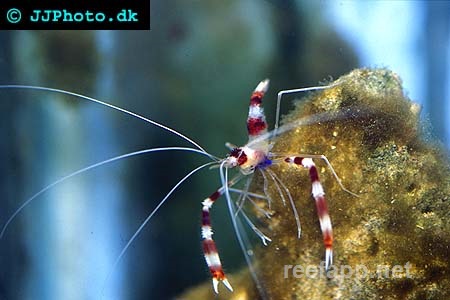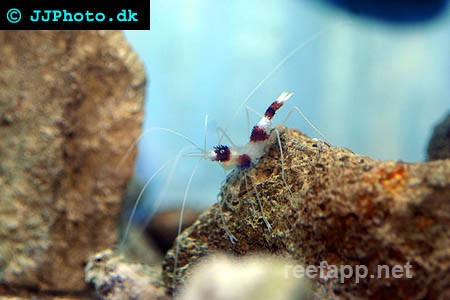Stenopus hispidus


| Latin name | Stenopus hispidus |
|---|---|
| Local name | Banded cleaner shrimp |
| Family | Alpheoidea - Stenopus |
| Origin | East Indian Ocean, Australia, The Mexican Golf, Indonesia, East Pacific, New Zealand, Central/West Pacific |
| Max length | 6 cm (2.4") |
| Minimum volume |
50 l (13 gal) |
|---|---|
| Hardiness |
Hardy |
| Suitable for aquarium |
Suitable for most aquarium |
| Reef safe |
Reef safe with caution |
| Aggressiveness | Mostly peaceful but might be aggressive towards similar species |
| Recommended |
Small crustaceans (Krill, mysis, artemia...) |
|---|---|
| Mostly |
Detritus Parasites |
This spicies might be a threat to smaller fishes.
This species can be a threat towards small crustaceans, e.g. small shrimp.
They can live as a pair provided they are introduced simultaneously.
These shrimps will sometimes irritate corals by taking food out of their mouths, but this is not generally a problem.
This species is able to remove parasites from fish.
It does not have a great impact on a large outbreak of marine ich (Cryptocaryon), for example, but it contributes towards keeping fish parasite free.
Constant cleaning can stress the fish in the aquarium, so one should not add this fish which removes parasites, if the fish are already weakened through other causes.
Not all specimens actively clean fish.
Shrimps have many different purposes in the tank, some are just pretty while others are shy but useful. Some remove parasites whilst others help fight different pests.
Read more about the different genera and species for more specific information.
Stenopus hispidus - Wikipedia - (English)
Bob Fenner. The Banded Coral Shrimp, Stenopus hispidus - Wet Web Media - (English)
Ronald L. Shimek. 2004. Marine Invertebrates (PocketExpert Guide) - TFH Publications / Microcosm Ltd. - (English)
Bob Fenner. Cleaner Shrimps of the Family Hippolytidae - Wet Web Media - (English)
James W. Fatherree. A Few Common Shrimps for the Marine Aquarium - Wet Web Media - (English)

